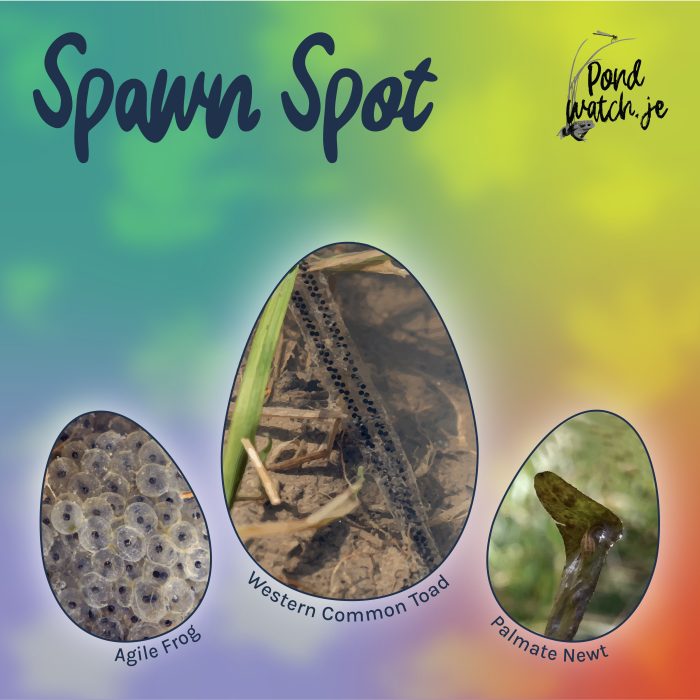
Spring weather has truly arrived and marks the start of the season for new life. Pondwatch.je are asking for your help to spot toads, frogs, and newt eggs in ponds this Easter holiday. Spend 30minutes visually looking for these eggs before sharing what you spotted or didn’t see at https://www.jerseybiodiversitycentre.org.je/pondwatch/level-1-form
It’s just as important to have information on where people are not seeing these amphibian eggs as they are an indication of health in the environment. Even if you don’t see the eggs but still spend 30minutes visually looking we want to know.
Spot the difference between these different amphibian eggs. The western toad eggs are laid in long double strings and the eggs are black circular shapes along the jelly like protection. A female can lay a huge number of eggs up to 1,500 and after 10 days they will emerge as tadpoles. Over time algae will grow over the eggs making them camouflaged from predators and harder for us to spot them. If you’re doing any pond dipping at this time of year please don’t disturb these eggs or remove them from the pond.
Agile frog eggs are laid in balls of spawn and the female carefully attaches the spawn to sunken twigs to keep it still and safe. The environment department has been helping the Agile frogs by building new ponds for them and sinking sticks, so they have something to hold their eggs in place.
Watch out for dropping water levels in your pond and help the eggs by filling it back up with rainwater. Another thing to spot is any ducks relaxing on your pond may find these eggs a tasty snack if they can reach them. Add sightings of ducks to your recording sheet if you see on sitting on or near your pond.
The Palmate newt eggs are by far the most complicated and hardest to spot. The female carefully folds each egg individually in a leaf creating a parcel to hide it whilst the tadpole develops. For this spawn you’re looking for folded leaves in a pond so make sure to bring your glasses!
Spotting the spawn is a fun activity for all ages and will help you slow down this easter break. Looking for nature is a great way to take a mindful break for 30minutes.
Remember to share your effort of watching the pond for 30minutes here: https://www.jerseybiodiversitycentre.org.je/pondwatch/level-1-form. Even if you don’t spot spawn pondwatch.je would still like to know.
Website: Pondwatch JE | Jersey Biodiversity Centre
Jersey’s amphibians
The western toad (Bufo spinosus), known locally as the crapaud, is found throughout the island and breeds in both semi-natural water bodies and garden ponds. Rather than the spawn clumps laid by frogs, they lay strings of spawn.
The agile frog (Rana dalmatina) is Jersey’s rarest amphibian, occurring in only a few ponds in the southwest of the island after almost going extinct in the 1980’s. It is now part of a long-term recovery project which is steadily helping the population.
The palmate newt (Lissotriton helveticus) is Jersey’s only newt species. It is found in garden ponds and other water bodies, but is under-recorded. Its eggs are harder to spot than those of frogs and toads, as they lay them singly folded in the leaves of pond plants.
If you currently do not have time to commit to carrying out these surveys please record any sighting you have and add a casual record.
PondWatch Partners: Jersey Biodiversity Centre, Government of Jersey, Jersey Amphibian and Reptile Group (JARG), Amphibian and Reptile Conservation (ARC).




